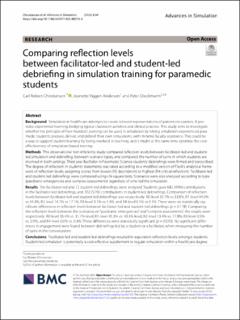| dc.description.abstract | Background Simulation in healthcare attempts to create relevant representations of patient encounters. It pro-
vides experiential learning, bridging typical classroom activities and clinical practice. This study aims to investigate
whether the principle of Peer-Assisted Learning can be used in simulation by letting simulation-experienced para-
medic students prepare, deliver, and debrief their own simulations, with minimal faculty assistance. This could be
a way to support student learning by being involved in teaching, and it might at the same time optimise the cost-
effectiveness of simulation-based training.
Methods This observational non-inferiority study compared reflection levels between facilitator-led and student-
led simulation and debriefing, between scenario types, and compared the number of turns in which students are
involved in both settings. Third-year Bachelor in Paramedic Science students’ debriefings were filmed and transcribed.
The degree of reflection in students’ statements was rated according to a modified version of Fleck’s analytical frame-
work of reflection levels, assigning scores from lowest (R0 description) to highest (R4 critical reflection). Facilitator-led
and student-led debriefings were compared using chi-square tests. Scenarios were also analysed according to type
(paediatric emergencies and complex assessments) regardless of who led the simulation.
Results Ten facilitator-led and 12 student-led debriefings were analysed. Students gave 682 (49%) contributions
in the facilitator-led debriefings, and 702 (51%) contributions in student-led debriefings. Comparison of reflection
levels between facilitator-led and student-led debriefings was respectively: R0-level 32.7% vs 33.8%, R1-level 44.0%
vs 44.3%, R2-level 14.7% vs 17.1%, R3-level 0.1% vs 1.3%, and R4-level 0.1% vs 0.1%. There were no statistically sig-
nificant differences in reflection levels between facilitator-led and student-led debriefings (p = 0.178). Comparing
the reflection levels between the scenarios on “paediatric emergencies” and “complex assessments”, the results were
respectively: R0-level 35.4% vs. 31.7%-level, R1-level 45.3% vs. 43.3%-level, R2-level 13.4% vs. 17.8%, R3-level 0.5%
vs. 0.9%, and R4-level 0.0% vs. 0.3%. These differences were statistically significant (p = 0.010). No significant differ-
ences in engagement were found between debriefings led by a student or a facilitator, when measuring the number
of turns in the conversations. | en_US |

